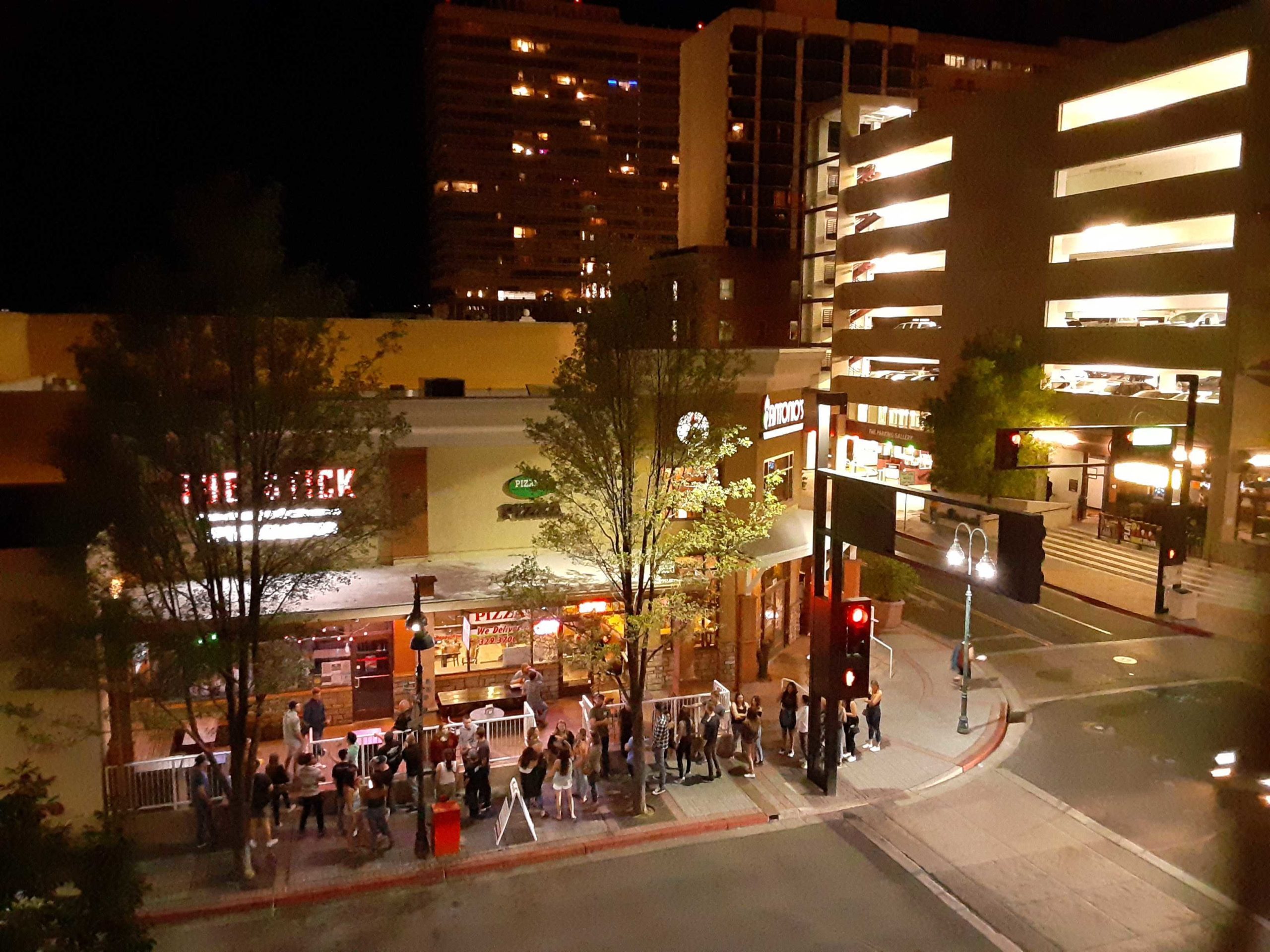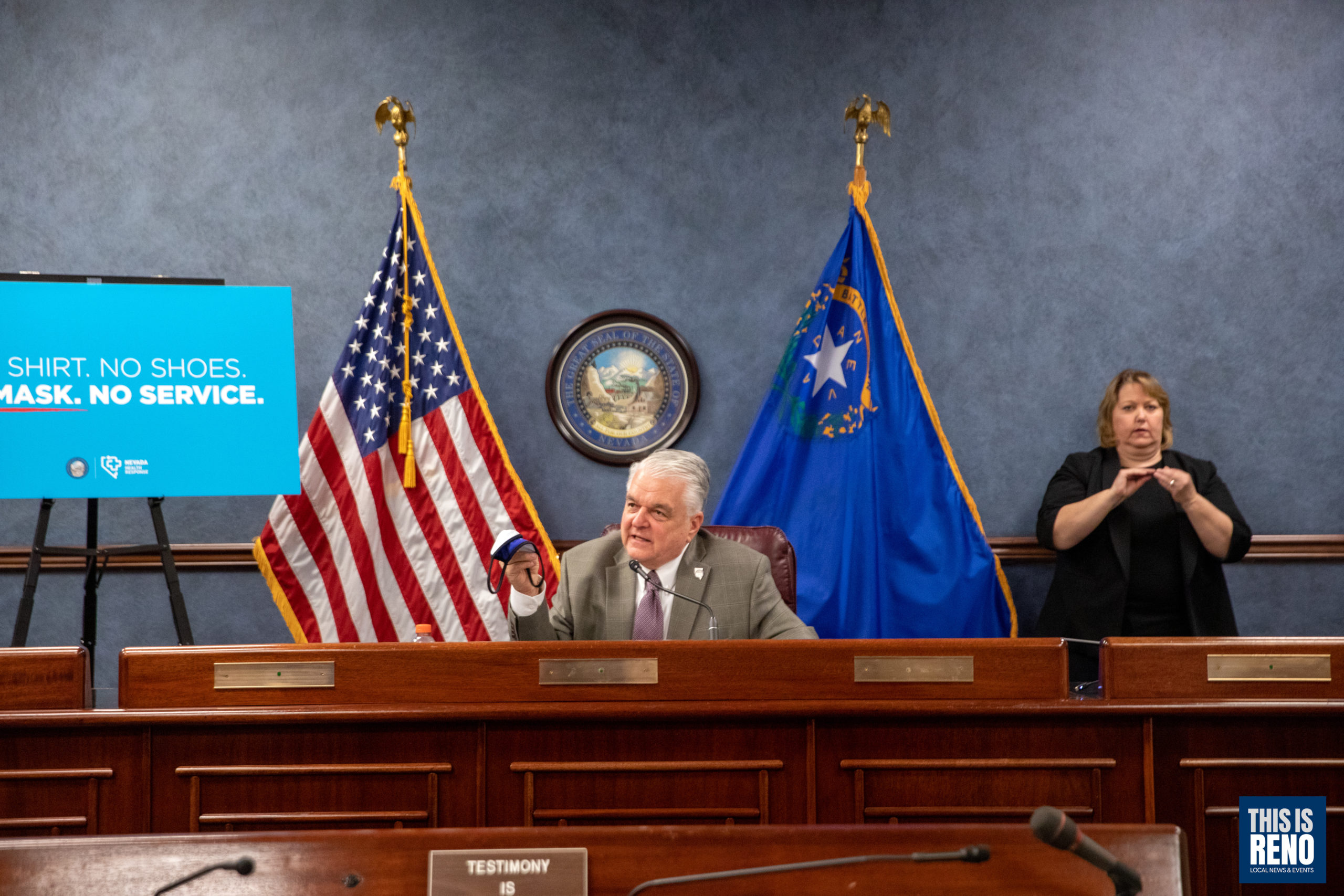By Lucia Starbuck | Images by Eric Marks | Video by Don Dike Anukam
Nevada has seen a surge of new COVID-19 cases and a steady increase in hospitalizations for the virus since entering phase two of Gov. Steve Sisolak’s reopening plan. The state surpassed 400 additional cases in one day, on multiple days.
In response to the spike in cases, Sisolak signed a directive that will require people to wear face coverings in public settings starting Friday, in an effort to limit the spread the state has experienced.
Individuals do not need to rush out and procure an N95 mask for themselves, but can fashion one of their own. The Centers for Disease Control and Prevention recommends cloth face coverings be worn in public settings.
“I don’t know why or when protecting our health and our neighbors’ lives became a political, partisan or even philosophical decision,” Sisolak said during his press conference on June 24. “For me, it’s none of those. It’s a medical necessity, a human obligation, and it’s good for business.”
Leaving the house? Here’s when you should wear a mask
Nevada residents and visitors over the age of 10 while in a public setting, including:
- Indoors in a public space.
- Outside in a public space when maintaining six-feet of social distancing from others outside of one’s household is not possible.
Masks are required on shared transportation services, including:
- Waiting for or riding public transportation.
- Taxis, monorails and trams.
- Rideshare services like Lyft and Uber.
- Masks are highly recommended when driving a personal vehicle with passengers outside of one’s household.
Face coverings required in works settings, including:
- Employees interacting with members of the public.
- Employees working in a space and who interact with the public, even if no one is present at the time.
- Any space where food is prepared or packaged for distribution.
- Walking through common areas, like hallways, staircases, elevators and parking facilities.
Exemptions to the mask mandate:
Young children
- Children under the age of 2 should avoid wearing masks.
- Children from the age of 2 to 9 are highly recommended to wear a face covering.
Activities that do not require masks:
- Undergoing a service on or in the mouth and nose.
- Eating or drinking at a restaurant.
- Engaged in an outdoor activity, including swimming, hiking, walking, biking and running when one is able to maintain six feet of social distancing from people outside of one’s household.
Populations that are not required to wear masks:
- People experiencing homelessness.
- People who are incarcerated.
- Individuals with disabilities or medical conditions that prevent them from wearing a mask, especially if wearing a face covering obstructs breathing, or if one cannot remove their mask without assistance. Face shields are recommended.
- Individuals who are unconscious.
- People who are hearing impaired, or when communicating with someone who is hearing impaired when seeing someone’s mouth is crucial for communication.
- Workers in professions in which wearing a mask would put them at risk, including law enforcement.
Sisolak did not get into specifics on punishment for individuals who refuse to wear masks in public settings. He said he’s hopeful it won’t have to go there.
“I want to be clear. This is a mandate. So, enforcement language is necessary,” Sisolak said. “However, ideally there won’t be any criminal civil sanctions for individuals. The last thing I want is for monetary fines or criminal penalties to be imposed on Nevadans, which is why I strongly encourage everyone to follow this directive.”
Sisolak did not set a date for when the mask mandate will expire and said any discussions of Nevada entering phase three will be tabled for the time being.
Law enforcement exempt from mask mandate
Law enforcement are not required to wear masks, despite working in close contact with members of the public.
This Is Reno reported that there were over a dozen law enforcement coming into close quarters with Black Lives Matter demonstrators in Carson City on June 20. Protestors and people eating lunch at an outdoor patio began yelling at one another after someone who was seated yelled, “Heil Hitler.” Law enforcement officers created a wall with their bodies between the protestors and restaurant goers.
Law enforcement had their backs to the patio and were facing protestors, sometimes less than a few inches face-to-face with demonstrators. Not one single officer was wearing a mask. One protestor asked why not and was told that it is personal preference.

RPD officers were also photographed by the ACLU of Nevada not wearing masks while citing unsheltered individuals living along the river who had not heeded the City of Reno’s notice to leave the area on June 17.
During the early stages of the pandemic, This Is Reno photographed a Reno Police Department officer unmasked, shaking hands with a reopen protest organizer in Reno on April 25.
However, according to the governor’s directive, people do not have to wear masks if their profession puts them at greater risk.
Sisolak’s directive exempts “individuals for whom wearing a face covering would create a risk to the person related to their work, as determined by local, state or federal regulators or workplace safety guidelines.”
“As the Gov. stated, the decision will be made locally,” Meghin Delaney, the public information officer for the Nevada Health Response, told This Is Reno in an email.
Sisolak said it’s up to the individual law enforcement agency to make the decision whether to wear masks or not.
“Depending on when they’re making stops, and the enforcement of their job, some of the sheriffs and police chiefs have opined that there’s a safety issue,” Sisolak answered This Is Reno during his press conference last night. “We’re leaving it up to the law enforcement agency to make that determination as it relates to their specific job function.”
This Is Reno was about to ask for clarification on the safety issues raised but was cut off by Delaney, who moved on to the next media representative in line.
COVID-19 spikes in Nevada and Washoe County
Nevada has reported more than 100 new cases of COVID-19 per day almost every day since the state entered phase one of the governor’s reopening plan, according to the Nevada Department of Health and Human Services’ dashboard.
The state reported more than 400 additional cases per day on several days. Nevada saw 462 cases on Monday, the highest jump in cases the state has seen.
Sisolak said the surge in cases is not due to increased COVID-19 testing.

“Increased testing is not the sole responsible reason for our numbers going up. This right here has a lot to do with why numbers are going up,” Sisolak said while pointing to his mask. “People aren’t wearing these. That has a significant impact.”
There has been a steady increase in Nevada’s cumulative positivity rate, which calculates the percentage of how many positive cases there are out of all tests performed for COVID-19.
During Sisolak’s press conference on June 15, he stated that Nevada’s cumulative positivity rate was 5.2 percent. Since June 17, the cumulative test positivity rate has been increasing by about one percent, and was 5.7 percent as of June 23.
Sisolak also admitted he has been in public without a mask, and noted that he has seen videos of large gatherings of people with little to no social distancing.
“I also made an error in judgment while out to dinner with my wife, where I was photographed not wearing a mask; it was an error, and it was inexcusable,” Sisolak said. “Too many Nevadans have had the same lapse of judgment. Every hour, there are photographs, videos posted of large unmasked clusters of people, clusters of potential COVID-19 spread.”
The state ramped up its contact tracing efforts. Julia Peek, a deputy administrator for the state’s Division of Public and Behavioral Health and Community Health Services, said there are more robust questions, including asking people who have tested positive for COVID-19 if they have participated in any public gatherings, and if so what kind.
“We did pull data from June 4 to June 16, and we re-called all those cases. So, I appreciate the patience of those cases who were called. Approximately 11 percent had been to a mass gathering and 12 percent had been to a civic activist event,” Peek said at Sisokak’s press conference.
Sisolak also stated that there has been a steady increase in hospitalizations for COVID-19. There are currently 439 individuals hospitalized for COVID-19 as of June 24.
Washoe County is seeing similar trends. Washoe County reported 90 additional cases of COVID-19 and the highest amount of active cases, at 748, yesterday.
The seven-day rolling average, which calculates the average number of new COVID-19 cases over a seven day period, was at 50 yesterday in Washoe County, the highest average the county has ever seen.
There are currently 73 individuals hospitalized for COVID-19 in Washoe County, which is tied for the highest number the county has seen. Additionally, 77 percent of staffed, short-term acute-care hospital beds are occupied as of June 24, which is a 21 percent increase from June 23, according to the Nevada Hospital Association.
Other fallout from pandemic
Sisolak also addressed budget shortfalls Nevada will face in the current and next fiscal years. Sisolak declared a fiscal state of emergency in mid May.
“Our state budget and economy have been directly impacted by the public health crisis,” Sisolak said.
The governor said he expects Nevada’s general fund to be short by about $1.27 billion, which is about a quarter of the state’s annual operating budget for the fiscal year 2021.
General funds are put toward state programs and agencies, including education, conservation efforts, criminal justice and public health services.
Sisolak said the state has taken efforts to lessen the shortfall for fiscal year 2020, including transferring money from the state’s Rainy Day Fund and reducing the operating budget by about $67.5 million.
Additionally, Sisolak ordered a moratorium on evictions in March, and that directive is set to expire in less than a week, at the end of June. Sisolak said he does not have any further details.
“We’re going to be addressing the expiration of the moratorium in the next few days. We’re still gathering some data and talking to some of the groups that are involved in this, and we should have an update for that in the next couple of days, as it relates to the eviction moratorium,” Sisolak said.
Sisolak said the state is considering having a phased-in rollback approach to lifting the eviction moratorium.

